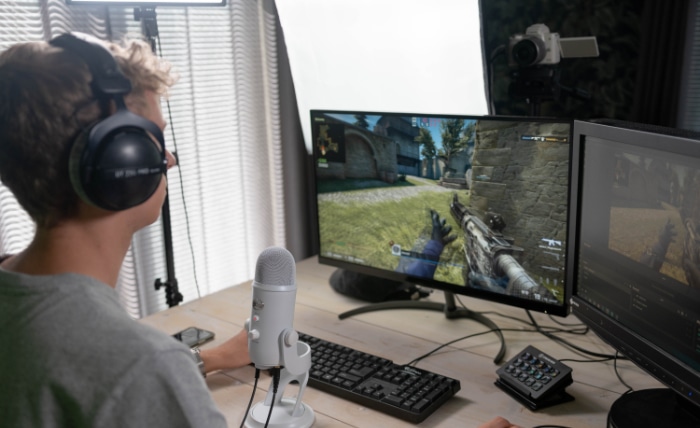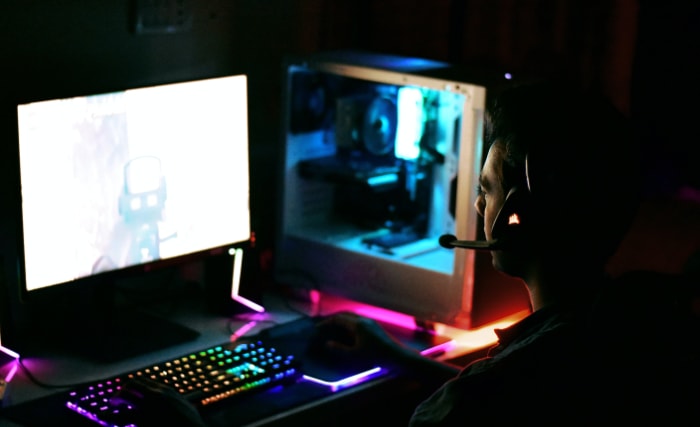Triple Buffering Explained: Enhance Your Gaming Experience

In the world of gaming, a smooth and immersive visual experience is essential for maximum enjoyment. As technology advances, game developers continue to push the boundaries of graphical fidelity. However, with these improvements come new challenges in delivering optimal performance.
One such solution that has gained popularity among gamers is Triple Buffering. But what exactly is Triple Buffering, and how does it impact your gaming experience?
This blog aims to provide a comprehensive understanding of Triple Buffering, its role in enhancing frame rendering, and how it can boost your overall gaming experience. We will explore the basics of rendering and buffering, discuss the benefits of Triple Buffering, and explore its limitations.
The Basics of Rendering and Buffering
Before diving into Triple Buffering, it is essential to understand the foundational concepts of rendering and buffering in gaming.
Understanding Rendering: The Foundation of Game Visuals
Rendering is the process of generating an image from a digital representation of a scene or object. In the context of video games, rendering involves taking the 3D models, textures, lighting, and other visual elements created by game developers, and converting them into 2D images displayed on your screen. This process occurs in real-time and is critical to creating a visually immersive gaming experience.
The Importance of Rendering in Gaming
A high-quality rendering process can significantly enhance the overall gaming experience by providing realistic graphics, smooth animations, and seamless transitions between different game environments. It also allows for more complex and detailed scenes, which can help to create a more engaging and dynamic gaming experience for players.
Buffering: Tackling Screen Tearing and Stutter
Buffering is a technique used to minimize visual artifacts such as screen tearing and stuttering that can occur when the frame rate of a game doesn't match the refresh rate of the display.
Screen tearing occurs when a new frame is displayed before the previous one has finished, while stuttering is caused by uneven frame rates, leading to jarring and inconsistent visuals.
Double Buffering: A Common Solution
Double buffering is a widely used technique to address screen tearing and stuttering. It involves using two buffers, known as the front and back buffers. The front buffer displays the current frame on the screen, while the back buffer is used to render the next frame.
When the next frame is ready, the front and back buffers are swapped, allowing the new frame to be displayed without overwriting the previous one. This reduces screen tearing and provides a smoother visual experience.
Introducing Triple Buffering
To address some of the limitations of Double Buffering and further improve gaming performance, Triple Buffering was developed.
The Evolution of Buffering Techniques: Triple Buffering
As technology advanced and the demand for smoother gaming experiences increased, a new technique called Triple Buffering emerged. Triple Buffering was developed to address some of the limitations of Double Buffering while further improving the overall gaming experience by maintaining a more consistent frame rate.
How Triple Buffering Works
Triple Buffering utilizes three buffers instead of two, as in Double Buffering. These buffers are the front buffer, the back buffer, and a third buffer. The front buffer still serves the purpose of displaying the current frame on the screen, while the back and third buffers are used for rendering new frames.
Swapping and Rendering Process
The swapping and rendering process in Triple Buffering is more dynamic than in Double Buffering. When a new frame is ready, it is swapped with the front buffer, while the third buffer immediately starts rendering the next frame.
This process ensures that there is always a new frame ready to be displayed as soon as the front buffer is updated, thus maintaining a consistent frame rate.
Comparing Triple Buffering to Double Buffering
Triple Buffering allows the GPU to work more efficiently, as it can render new frames continuously without having to wait for the front buffer to be updated. This can lead to higher frame rates, providing a more fluid gaming experience, especially on high-refresh-rate monitors.
Smoother Gaming Experience
The combination of improved frame rates leads to a smoother gaming experience. Triple Buffering helps to minimize screen tearing and stuttering while allowing for more fluid gameplay, making it a preferred choice for many gamers.
Benefits of Triple Buffering
Triple Buffering offers several advantages over traditional Double Buffering, making it an attractive option for gamers looking to maximize their gaming experience.
Enhanced Gaming Performance
Triple Buffering improves gaming performance by allowing the GPU to work more efficiently. With three buffers, the GPU can continue rendering new frames without waiting for the front buffer to be updated. This can result in higher frame rates and a more fluid gaming experience.
Consistent Frame Rates
By utilizing a third buffer for rendering, Triple Buffering helps maintain a more consistent frame rate. This consistency is crucial for providing a smooth and enjoyable gaming experience, as it reduces the chances of stuttering and other visual artifacts that can be distracting for players.
Better Visual Quality
With the ability to render more frames per second, Triple Buffering can contribute to better visual quality in games. This is especially noticeable in fast-paced games and those with complex graphics, where a higher frame rate can lead to a clearer and more immersive visual experience.
Reduction in Screen Tearing and Stutter
Triple Buffering is effective in reducing screen tearing and stutter by ensuring that there is always a new frame ready to be displayed. This minimizes the occurrence of visual artifacts and provides a smoother gaming experience.
Limitations and Drawbacks of Triple Buffering

While Triple Buffering provides a range of benefits, it is not without its limitations and drawbacks.
Increased GPU and Memory Usage
One of the main drawbacks of Triple Buffering is that it requires more GPU and memory resources than Double Buffering. With three buffers instead of two, the GPU must allocate additional memory for rendering, which can be a concern for systems with limited resources or when playing games with high system requirements.
Compatibility with Different Sync Technologies
While Triple Buffering generally helps maintain consistent frame rates, it's essential to understand that it may not be universally compatible with all sync technologies.
For instance, some gamers might prefer using other synchronization options like NVIDIA's G-SYNC or AMD's FreeSync, which dynamically adjust the refresh rate of the display to match the frame rate of the GPU. In such cases, Triple Buffering may not provide the same level of benefit as when used with traditional V-Sync.
As a result, it's crucial for gamers to consider their specific hardware and monitor capabilities when evaluating the benefits of Triple Buffering.
Not Universally Supported by All Games and Hardware
Triple Buffering is not universally supported across all games and hardware configurations. Some games may not offer the option to enable Triple Buffering in their settings, while others may not benefit significantly from it due to the way they handle rendering.
Additionally, certain hardware configurations may not be compatible with Triple Buffering. As a result, the actual performance improvements and benefits of Triple Buffering can vary depending on the game and hardware being used.
Enabling Triple Buffering
Now that you have a better understanding of Triple Buffering, its benefits, and limitations, you might be wondering how to enable it for your gaming setup.
How to Enable Triple Buffering on Various Platforms
NVIDIA Control Panel
For NVIDIA GPU users, you can enable Triple Buffering through the NVIDIA Control Panel. Here's how:
- Right-click on your desktop and select “NVIDIA Control Panel.”
- In the left-hand menu, navigate to “3D Settings” and then click on “Manage 3D settings.”
- Scroll down to the “Vertical Sync” setting and set it to “On” or “Adaptive.”
- Find the “Triple Buffering” option and set it to “On.”
- Click “Apply” to save the changes.
AMD Radeon Settings
For AMD GPU users, enabling Triple Buffering can be done through the AMD Radeon Settings:
- Right-click on your desktop and select “AMD Radeon Settings.”
- Navigate to the “Gaming” tab and select the game you want to configure.
- Locate the “Wait for Vertical Refresh” setting and set it to “Enhanced Sync” or “Always On.”
- Find the “Triple Buffering” option and set it to “On.”
- Click “Apply” to save the changes.
In-Game Settings
Some games offer built-in options to enable Triple Buffering. To enable it within a game:
- Open the game and navigate to its graphics or video settings.
- Look for an option called “Triple Buffering,” “V-Sync Triple Buffering,” or something similar.
- Enable the option and apply the changes.
Tips for Optimizing Triple Buffering
Monitor Your Frame Rate: Keep an eye on your frame rate to ensure that Triple Buffering is providing the desired performance improvements. You can use built-in tools like NVIDIA's GeForce Experience or AMD's Radeon Overlay to monitor your frame rate in real-time.
Adjust Graphics Settings: If you experience performance issues after enabling Triple Buffering, consider adjusting your in-game graphics settings. Lowering settings like texture quality, shadows, or anti-aliasing can help improve performance and maintain a smoother gaming experience.
Update Your GPU Drivers: Ensure that your GPU drivers are up to date, as newer drivers can provide performance optimizations and support for Triple Buffering in more games.
Experiment with Different Sync Options: If Triple Buffering doesn't provide the desired results, experiment with other synchronization options like Fast Sync (NVIDIA) or Enhanced Sync (AMD) to find the best solution for your specific hardware and gaming preferences.
Conclusion
In conclusion, Triple Buffering is a powerful technique that can significantly enhance your gaming experience by addressing issues like screen tearing and stuttering. By leveraging three buffers instead of two, Triple Buffering enables higher frame rates and a smoother visual experience. However, it's essential to be aware of the limitations and potential drawbacks, such as increased GPU and memory usage.
Enabling Triple Buffering depends on your specific hardware and the games you play, so it's important to familiarize yourself with the settings and options available through your GPU control panel or in-game settings. Remember to monitor your frame rate, adjust your graphics settings if needed, and experiment with different synchronization options to find the optimal configuration for your gaming experience.
By understanding the benefits and limitations of Triple Buffering, you can make informed decisions about whether this technique is right for you and how to enable it for the best results. Happy gaming!


